Sunday, October 16, 2011
The Oldest Hockey Sweater in the World - 1894 Queen's University Guy Curtis Jersey
Founded on this date in 1841 in Kingston, Ontario, 26 years before Canada even became a country, Queen's University is considered one of the finest academic institutions in Canada.
Today, "Queen's" as it is commonly referred to, has roughly 21,500 students and annually receives 25,000 applications for it's 3,400 openings for new students. It currently consists of 17 different schools, some of which are Arts and Sciences, Music, Computing, English, various Health Sciences, Law, Business and Education.
It's founder was Thomas Liddell, who arrived from Scotland with a Royal Charter from Queen Victoria, and established Queen's College as an educational institution. In 1991, the the University celebrated it's 150th anniversary, which was highlighted by a visit from Prince Charles and his wife Diana.
The Queen's University athletics program, which dates back to 1873, is among the largest of it's kind in Canada and it's teams are known as the Golden Gaels, a name which came into being in 1947. Prior to that, they were known as "The Tricolor" in recognition of their school colors of blue, gold and red.
It also plays and important role in the creation of modern ice hockey and it's history. One common claim is that a match between Queen's and the Royal Military College on Kingston Harbour in 1886 was the origination of game of hockey, although similar claims also come from earlier events in Montreal, Ottawa and Halifax.
The Queen's University hockey club champions of 1888
Although their game may not have been the first, Queen's and the Royal Military College still play each other annually for the Carr-Harris Cup in the world's oldest hockey rivalry.
Queen's University and the Royal Military College competing for the Carr-Harris Cup in throwback jerseys
Regardless of where it may have began, hockey continued to be played at Queen's and on March 9, 1895 Queen's University, champions of the Ontario Hockey Association, became only the second challengers for the brand new symbol of hockey supremacy in Canada, the Stanley Cup.
In a single game challenge, Queen's was turned away by the host Montreal Hockey Club by a score of 5-1 with the lone Queen's goal scored by a player named McKay.
The 1895 Queen's University hockey club
March 14, 1899 saw Queen's University again challenge for the Stanley Cup, once more traveling to Montreal, only this time to take on the Montreal Shamrocks of the Canadian Amateur Hockey League in another single game challenge. The results were very much the same as the previous challenge, with Queen's being turned away 6-2, with their goals being scored by G. P. Dalton and R. R. Harris.
"The Shamrocks are altogether overestimated, and I am sure that if we had been playing in the Quebec League with them this year we could have won out without much trouble. The greatest drawback to Queen's was the size of the rink, which difficulty could be overcome with a few practices upon it," captain Guy Curtis was quoted as saying the newspapers the following day.
By 1906, Queen's University were now members and champions of the Ontario Hockey Association, giving them the right to make Queen's third and final challenge for the Stanley Cup, increasingly the property of professional clubs.
Queen's faced an uphill battle from the start, as their opponents were the legendary Ottawa Silver Seven (later the Senators) who had been in possession of the Stanley Cup since March of 1903 and had five future Hockey Hall of Famers on it's roster and had successfully fended off nine consecutive cup challenges prior to facing Queen's.
Undaunted, Queen's travelled to Ottawa for a best-of-three series which began on February 27th, 1906. Queen's kept Game 1 close just past the halfway mark, when the score was 5-4, only to have the mighty Silver Seven romp away to a 16-7 win a Harry Westwick, Alf Smith, Harry Smith and Frank McGee each scoring four goals apiece.
Game 2 was another romp for the Ottawa Hockey Club, as they clinched the series and retained the cup with a 12-7 victory.
The 1906 Queen's University Stanley Cup challengers
Three years later, with the Stanley Cup now awarded to professional teams, a new trophy was created for the top amateur team in Canada, the Allan Cup. It was awarded to the Ottawa Cliffsides as champions of their league. One week later, on March 13, 1909, they were challenged by Queen's University, who won the match 5-4 to take over possession of the new trophy, as shown in the upper left of the photo below.
The 1909 Queen's University hockey club, holders of the Allan Cup
The modern day Golden Gaels hockey program currently participates in the Ontario University Athletics conference where they have competed for the Queen's Cup since the University donated it to the conference in 1903. Queen's have won the cup six times, those coming in 1904, 1906, 1909, 1910, 1914 and then, following a 67-year drought, again in 1981.
In the 1940's, Captain James Sutherland, a staunch supporter of Kingston as the location of the birth of hockey, proposed that a study be done on the origin of hockey, which soon evolved into a movement to form a hockey hall of fame. With it's central location between Montreal and Toronto, Kingston became the chosen location of what is now the International Hockey Hall of Fame.
One of the main features of the museum is the exhibit dedicated to former coach and well-known television commentator on Hockey Night in Canada, Don Cherry, who is a native of Kingston. On display is one of Cherry's trademark loud sport jackets and high-collared shirts as well as various items from his days as a youth, junior and professional player and coach.
Don Cherry
The main floor of the hall is where you can find the "Original Six" collection, which features sweaters, sticks and photographs of all-time greats such as Henri Richard, Jean Beliveau, Gordie Howe and Johnny Bower.
Montreal Canadiens jerseys from Henri Richard and Jean Beliveau
The "International Exhibit" highlights some of the great moments in international hockey, and some of the artifacts include a gold medal won by Canada at the 1924 Winter Olympics, a stick signed by the Soviet team from the 1972 Summit Series and a collection of various national team jerseys.
Finally, the "Kingston Collection" highlights some of Kingston's greatest players, such as Syl Apps, Bill and Bun Cook, Doug Gilmour, Kirk Muller, Alyn MacCauley and Jay McKee. Also in the second floor gallery is a Wayne Gretzky Edmonton Oilers jersey from the Oilers first season in the NHL and a trio of WHA Houston Aeros jerseys from Mark, Marty and Gordie Howe.
Jerseys from the Howe family during their days with Houston of the WHA
As interesting as all those items truly are, the one thing that stands out to us as the most important and historically significant item is today's featured jersey, a 1894 Queen's University Guy Curtis jersey, reputed to be the oldest hockey jersey in existence.
Curtis was the premier athlete at Queen's University during the 19th century. Before the modern eligibility rules, Curtis played for the football team for 12 years, from 1886 to 1898, and as team captain and coach, drew up complex plays while leading Queen's to it's first Dominion Football Championship in 1893.
He was also captain of the school's hockey team and twice participated in the first two of their Stanley Cup challenges as well as playing in ten Ontario Senior Hockey Championships, winning five of them before his playing career ended in 1902.
Guy Curtis
Curtis is credited with being instrumental in developing both football and hockey in Canada, as well as introducing hockey to the United States, as Queen's University was known for it's exhibition matches in American cities during his time with the club. He is so well thought of at Queen's that his name appears in a verse of the school song.
The wool sweater is in the classic barberpole style of the early days of hockey, executed in the Queen's University colors of blue, red and gold, with time having taken it's toll on the original shade of blue in particular, as it now appears more olive green due to fading of the pigment in the blue.
Special thanks to Mark Potter, President of the International Hockey Hall of Fame, for the assistance with information and photos of today's featured jersey.
Subscribe to:
Post Comments (Atom)

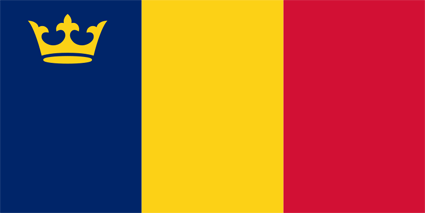
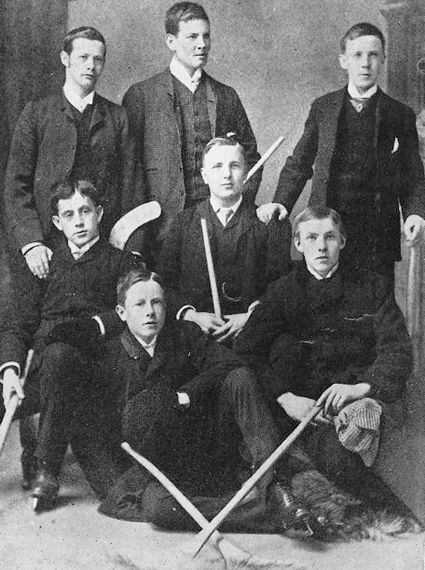

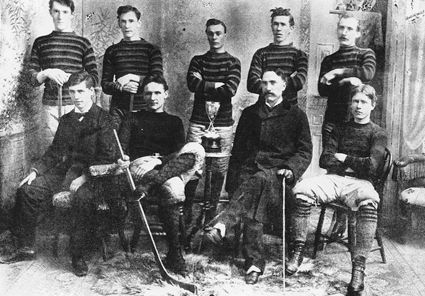
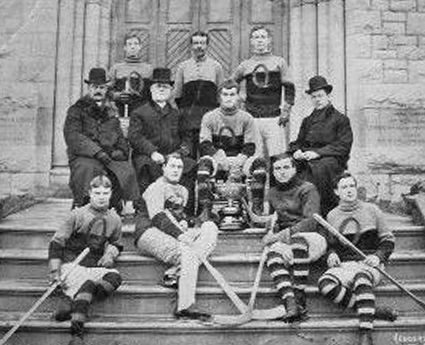
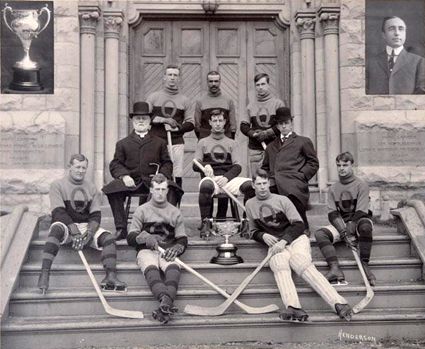
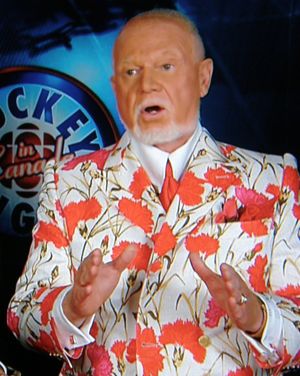
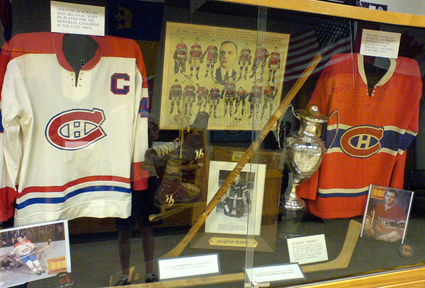

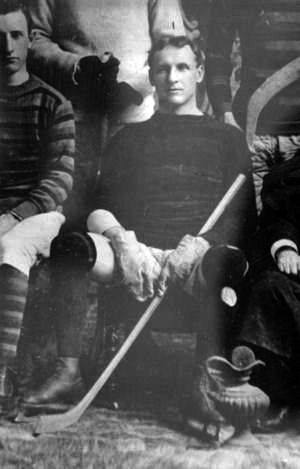
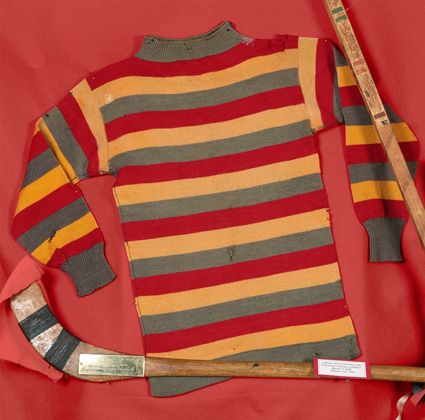










Excellent. Thanks for that.
ReplyDelete